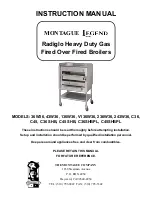
7
De-commissioning
SF300/5, SF400/5 – 6 720 800 028 (2012/05)
12
6.1
Commissioning the DHW cylinder
On the DHW side, the test pressure must not exceed 10 bar (150 psi)
positive pressure.
B
Flush the DHW cylinder and pipework thoroughly prior to
commissioning (
Æ
6.2
Instructing users
B
Explain the operation and handling of the heating system and DHW
cylinder, making a particular point of safety-relevant features.
B
Explain the function and checking of the safety valve.
B
Hand all enclosed documents over to the user.
B
User recommendation:
Arrange an inspection/maintenance
contract with an approved heating contractor. Have the DHW cylinder
inspected and, if required, serviced annually in accordance with the
service intervals stated (
Æ
B
Highlight the following for the user:
–
Water may be discharged from the safety valve during heat-up.
–
The safety valve discharge pipe must always be kept open.
–
Service intervals must be observed (
Æ
–
Recommendation in the case where there is a risk of frost and
when the user is briefly away:
Keep the DHW in operation and
select the lowest possible DHW temperature.
7
De-commissioning
B
If an immersion heater has been fitted (accessory), isolate the DHW
cylinder from the power supply (
Æ
B
Switch off the temperature controller at the control unit.
B
Drain the DHW cylinder (
Æ
Fig. 15 and 16, page 49).
B
Decommission all assemblies and accessories of the heating system
as specified in the manufacturer's technical documentation.
B
Close the shut-off valves (
Æ
B
Depressurize the external heat exchanger.
B
Drain and blow out the external heat exchanger (
Æ
B
To prevent corrosion, dry out the cylinder's inner space and keep the
inspection aperture covers open.
8
Environmental protection/Disposal
Environmental protection is a fundamental principle of the
Bosch Group.
Quality of products, efficiency and environmental protection are equally
important objectives for us. All legislation pertaining to the environment
is strictly observed.
Packaging
We are dedicated in adhering to country-specific disposal standards as
they relate to packaging to ensure optimum recycling. All packaging
materials are environmentally compatible and can be recycled.
Used appliances
Used appliances contain materials that should be recycled.The
assemblies are easy to separate and the types of plastic used are
identified. This allows the various assemblies to be appropriately sorted
for recycling or disposal.
9
Servicing
B
Let the DHW cylinder cool down sufficiently prior to any maintenance
work.
B
Carry out cleaning and maintenance procedures in the specified
intervals.
B
Remedy all faults immediately.
B
Use original spare parts only!
9.1
Maintenance intervals
Service the appliance in accordance with throughput, operating
temperature and water hardness (
Æ
The use of chlorinated DHW or a water softener unit reduce the service
intervals.
You can check the local water quality with your water supply utility.
Depending on the composition of the water, it can make sense to deviate
from the reference values listed.
9.2
Maintenance work
9.2.1 Checking the safety valve
B
Check the safety valve annually.
9.2.2 Descaling/cleaning the DHW cylinder
B
Disconnect the DHW cylinder on the DHW side from the pipework.
B
Close the shut-off valves and isolate the immersion heater from the
power supply (if installed) (
Æ
B
Drain the DHW cylinder (
Æ
B
Open the inspection aperture (
Æ
B
Check the DHW cylinder interior for contamination (lime scale
deposits, sediment).
Check the DHW cylinder for leaks using potable water
only.
WARNING:
Risk of scalding at the hot water draw-off
points!
There is a risk of scalding at the hot water draw-off
points if the DHW temperature is set above 60 °C and
during thermal disinfection.
B
Advise users that they should only draw off mixed
water.
WARNING:
Risk of scalding from hot water.
B
Let the DHW cylinder cool down sufficiently.
Water hardness in °dH
3 – 8.4
8.5 – 14
> 14
Calcium carbonate concentration
in mol/ m³
0.6 – 1.5
1.6 – 2.5
> 2.5
Temperatures
Months
At a standard throughput (< cylinder content/24 h)
< 60 °C
24
21
15
60 – 70 °C
21
18
12
> 70 °C
15
12
6
At a higher throughput (> cylinder content/24 h)
< 60 °C
21
18
12
60 – 70 °C
18
15
9
> 70 °C
12
9
6
Table 7 Service intervals in months
In order to improve the cleaning effect, heat up the
external heat exchanger prior to cleaning it with a water
jet. The thermal shock effect separates deposits (e.g.
lime scale build-up) more readily.
Содержание SF300.5
Страница 52: ...SF300 5 SF400 5 6 720 800 028 2012 05 52 27 6 720 646 958 23 1ITL 25 30 Nm 19 22 ft lbs ...
Страница 53: ...SF300 5 SF400 5 6 720 800 028 2012 05 53 ...
Страница 54: ...SF300 5 SF400 5 6 720 800 028 2012 05 54 ...
Страница 55: ...SF300 5 SF400 5 6 720 800 028 2012 05 55 ...
Страница 56: ...Bosch Thermotechnik GmbH Sophienstrasse 30 32 D 35576 Wetzlar www buderus com ...













































